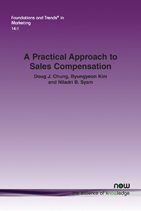A Practical Approach to Sales Compensation: What Do We Know Now? What Should We Know in the Future?
By Doug J. Chung, Harvard University, USA, dchung@hbs.edu | Byungyeon Kim, Harvard University, USA, bkim@hbs.edu | Niladri B. Syam, University of Missouri, USA, syamn@missouri.edu
Abstract
Personal selling represents one of the most important elements in the marketing mix, and appropriate management of the sales force is vital to achieving the organization’s objectives. Among the various instruments of sales management, compensation plays a pivotal role in motivating and incentivizing sales agents. This monograph reviews the evolution of research in sales compensation and discusses future trends and opportunities. Specifically, it examines the managerial relevance of the theoretical foundations, discussing the underlying reasons for their applicability (or lack thereof) in practice. Furthermore, the monograph surveys recent empirical methods—including field experiments and structural econometrics—that are practical for analyzing sales agents’ behavior under various compensation systems. It also discusses prominent areas of future research in the midst of a changing sales environment. In particular, this monograph sheds light on how the use of big data, machine learning, and artificial intelligence can affect sales strategy formulation and, thus, sales compensation systems to better motivate and incentivize an organization’s sales force.
A Practical Approach to Sales Compensation: What Do We Know Now? What Should We Know in the Future?
A Practical Approach to Sales Compensation takes readers through the evolution of academic research on sales compensation. By examining the relevance of existing research, it provides practical guidance on the design of an effective compensation system. Furthermore, the monograph discusses how recent technological advances in artificial intelligence (AI) and machine learning (ML) shape sales strategy transformation and, thus, sales compensation systems of the future.
After an introduction, Section 2 illustrates a practical outline for designing a sales compensation system and the associated dilemma that organizations often face. Section 3 examines the theoretical foundations of effective sales compensation structures and their validity—in particular, application of the principal-agent theory, which derives optimal compensation systems under the presence of agents’ moral hazard. Section 4 addresses recent developments in field research: randomized field experiments jointly conducted by academics and organizations as well as structural econometric methods using micro-level performance and compensation data. Section 5 illustrates how advances in technology affect organizations’ sales strategies and, thus, the challenges and opportunities in utilizing compensation structure to motivate salespeople.
